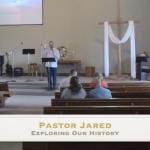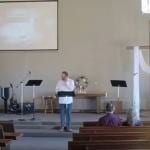I culled down this article from a reaction paper. We were given this open statement to support or disagree with. “The doctrine of the ‘epiklesis’ in the Eastern Rite provides a more adequate place for the work of the Holy Spirit in worship than was found in the Western Rite.”[1]
This is a communion topic. However, the topic narrows to the epiklesis, which also narrows again into historical views of transubstantiation. Although my research is more extensive, this article offers glimpses of the Spirit at work in the ancient Liturgy, as well as a couple Primitive Church prayers.
The Primitive Church in the ancient near East (aNE) is very diverse, geographically spread out, making it difficult to trace a question like this. The East has various regions that influence its development, from Alexandria to Jerusalem, Antioch to Damascus, and Edessa on the northeastern frontier of Syria.

epiklesis | Hippolytus, Sarapion,
and SS. Addai and Mari
The West is more centralized in Rome which seems to be reflected in their doctrinal development. In the East we find the epiklesis among the writings of Hippolytus, Sarapion, and the Liturgy of SS. Addai and Mari, among others. The epiklesis, though noticeably different at first, eventually becomes known as the prayer in the Liturgy when the Spirit descends and transforms the elements. Over time, the doctrine of the transformed elements has been referred to as transubstantiation. However, these early prayers point in a different direction.
i. Hippolytus
Hippolytus writes from Rome in the late 2nd Century.[2] Bard Thompson reviews the epiklesis as penned by Hippolytus: “Unlike the epiclesis in the later Greek rite, it did not make reference to the conversion of the elements; rather it asked that the Holy Spirit descending ‘upon the oblation of Holy Church,’ would work effectively in the hearts of the communicants.”[3]
For Hippolytus, the transformation occurs in the hearts of the believers who are receiving Eucharist. Here is the epiklesis of Hippolytus, if it can be called that:
And we pray Thee that [Thou wouldest send Thy Holy Spirit upon the oblation of Thy holy Church] Thou wouldest grant to all [Thy saints] who partake to be united [to Thee] that they may be fulfilled with the Holy Spirit for the confirmation of [their] faith in truth.[4]
Clearly Hippolytus believes the Holy Spirit accomplishes His work in the lives of the believers who receive communion.
ii. Sarapion
Sarapion writes before 350 A.D. His piece is called the Prayer of Oblation of Bishop Sarapion.[5] What follows is Sarapion’s epiklesis:
O God of truth, let Thy holy Word come upon (epidemesato) this bread that the bread may become Body of the Word, and upon this cup that the cup may become Blood of Truth.[6]
Dom Gregory Dix later explains Sarapion’s prayer for communion:
In contrast with Hippolytus, where the institution narrative is taken as implicitly identifying the bread and wine with the Body and Blood of Christ by virtue of His own promise, Sarapion’s prayer shews a new desire for an explicit identification. This desire is found in other fourth century writers also, but hardly before that time.[7]
This is an important note. Before the fourth century, we cannot really find the idea of transubstantiation. The Early Fathers seem to be describing a mystery implicitly. Whether or not the mystery they are referring to is transubstantiation is unknown. Of course, we can read any of our own views back into their statements. However, the later Fathers like Sarapion begin to explicitly describe transubstantiation.
Can we determine that the Primitive Church held to such a doctrine at all?
We certainly do not find such evidence in the early forms of the epiklesis. Instead, the prayers call upon the Spirit to bless the communicants.
Sarapion offers a hint of transubstantiation by claiming the Presence. However, Sarapion does not technically include a metaphysical transformation of the elements.
Sarapion’s epiklesis makes way in the East for the “moment of consecration.” In the fourth and fifth centuries the East eventually prays that, “the Holy Ghost, the Third Person of the Holy Trinity, would (in some sense) ‘make’ the elements into the Body and Blood of Christ. This became for them the ‘moment of consecration.’”[8]
iii. SS. Addai and Mari
Another Eastern rite is the Liturgy of SS. Addai and Mari.[9] This Liturgy stems from the far northeast church in the city of Edessa (northeast Syria or western Persia). The Apostle Thomas is thought to have pioneered the church at Edessa. The prayer for the invocation of the Spirit reads thus:
And may there come, O my Lord, Thy Holy Spirit and rest upon this oblation of Thy servants, and bless and hallow it that it be to us, O my Lord, for the pardon of offenses and the remission of sins and for the great hope of resurrection from the dead and for new life in the kingdom of heaven with all those who have been well-pleasing in Thy sight.[10]
Dix says this epiklesis, “is hardly an epiklesis at all, in that it does not actually pray for any sort of conversion of the elements, but for something quite different, namely for the benefits of communion.”[11] However, this is nonetheless a reference to the work of the Spirit.
The formulation of this epiklesis may be the result of a very early influence from Jerusalem, that of Thomas according to tradition. Dix makes a case that the Syrians may not have seen the Spirit in a New Testament sense, but in an Old Testament sense, as the presence or power of God.[12] He cites this as evidence for the early origins of this rite.
epiklesis without transubstantiation
While it is beyond the scope of this article to refute Dix on this point, it is hard to believe that if Thomas starts Edessa’s congregation, he simply forgets all the ways the Holy Spirit makes Himself known in Acts. Would Thomas forget how Jesus speaks of the Spirit as a Person in John’s version of the Last Supper?
There is another issue of importance that Dix does not focus on. He believes that SS. Addai and Mari is nearly a primitive rite, with roots in Jerusalem. If this is true then there are two very early liturgies that do not include the concept of transubstantiation (Hippolytus and SS. Addai and Mari).
The Continental Reformers would all have various views of communion. None would hold to transubstantiation, although I would contend that many Protestants today would be uncomfortable with Martin Luther’s view of communion. Although the Continental Reformers refute transubstantiation, there remains the question of the real Presence.
How is Christ present at the Table?
In effect, this question replaces the question of the epiklesis, as Protestants discuss this mystery.
Side note: By the way, enjoy Reformation Day, October 31st every year! If you have a couple sons, get them costumes to trick-or-treat as Luther and Tetzel!
the question at hand
The Eastern Rites do indeed seem to offer a more adequate place for the work of the Spirit than the West, at least in the early days.
The original research set out to answer a question about early developments of Pneumatology related to the epiklesis prayer of the Liturgy. Transubstantiation is an unexpected side issue that came to the fore in the process.
From prayers like the ones in this article, the East appears to be exploring Pneumatology, and possibly the real Presence at the Table, centuries before the West does in the Middle Ages. However, there are Fathers like Justin and Irenaeus that influence both East and West very early on. They are also describing some type of mystery at the Table. For articles related to their views on communion, see below.
Is the mystery the symbol, or what we ascribe to the symbol? These questions are beyond the scope of this article. However, when I find very ancient traditions, perhaps only one generation away from an Apostle, I pay attention.
My faith tribe adheres to a memorial view, that is if an outsider were to look at our doctrine and place us in a Theological camp. However, we use terms like “The Lord’s Supper . . . ordinance . . . commandment . . . memorial.”[13] These are hallowed terms to us, although they may not be the lingua franca of those who participate in Eucharist. Furthermore, there is a degree of freedom as to how we interpret these terms.
In this article, and in all my writings I have shared so far on the topic, I hope you see my reverent approach.
I sincerely pray that we all would be able to approach the Table together, more often. May we loosen our grip on our own particular nomenclature or semantics. We all seem to be trying to describe something that no one has ever fully been able to find the words to describe. May we recognize that our Lord is in some way overseeing the rite, blessing our participation as we obey His command, and binding our hearts together in unity.
Recent articles on communion:
Martin Luther, Justin Martyr, & Heidelberg at “The Table”CLICK HERE
Justin Martyr on Communion CLICK HERE
Irenaeus of Lyons on Communion CLICK HERE
notes:
[1] Jared V. Ingle, “Question 10,” Sacraments in History (paper presented at Asbury Theological Seminary, Wilmore, KY, November 18, 2016).[2 – 4] Bard Thompson, Liturgies of the Western Church (Philadelphia, PA: Fortress Press, 1980), 130, 18, 21.
[5 – 12] Dom Gregory Dix, The Shape of the Liturgy, 3rd ed. (New York, NY: Bloomsbury T&T Clark, 2015), 162-164, 167-168, 178-179, 183-185.
[13] PCG, “Beliefs & Bylaws: Statement of Faith,” Pentecostal Church of God (2020), accessed October 10, 2020, https://www.pcg.org/about/beliefs-bylaws













